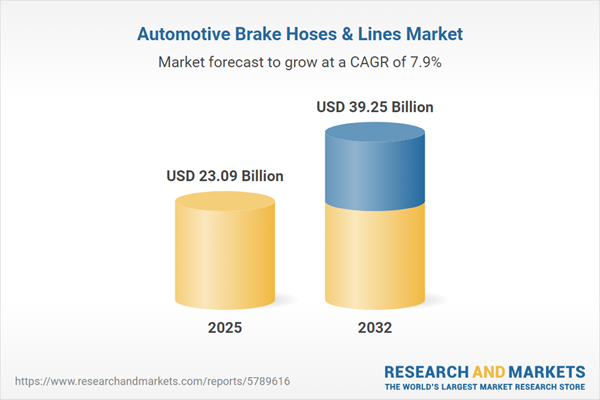Speak directly to the analyst to clarify any post sales queries you may have.
The automotive brake hoses and lines market is evolving rapidly, driven by ongoing innovation, regulatory change, and shifting procurement models. For senior decision-makers seeking to navigate a dynamic sector, targeted insights and actionable strategies are key to securing operational flexibility and maintaining a competitive edge.
Market Snapshot: Automotive Brake Hoses and Lines Market
In 2024, the automotive brake hoses and lines market reached USD 21.41 billion, marking a compound annual growth rate (CAGR) of 7.86%. Projections indicate a rise to USD 23.09 billion in the following year, with long-term estimates pointing toward USD 39.25 billion by 2032. Market expansion is powered by advanced vehicle safety mandates, growth in smart automotive technologies, and heightened global supply chain interconnectivity. As regulatory frameworks evolve and supplier dynamics shift, decision-makers are investing in realignment of sourcing strategies and operations to strengthen positions across traditional and emerging regions.
Scope & Segmentation of the Automotive Brake Hoses and Lines Market
- Product Types: Braided synthetic hoses deliver flexibility and high tensile strength for demanding vehicle environments; convoluted rubber hoses provide stable performance in dynamic movement assemblies; spiral braided PTFE hoses offer durability and chemical resistance for a range of applications; cold drawn steel tubes contribute to extended component longevity; seamless copper nickel tubes add robust corrosion resistance.
- Distribution Channels: Original equipment manufacturers (OEMs) facilitate streamlined production and integration for new vehicles; aftermarket networks extend access, enabling maintenance and system upgrades across multiple geographies and service models.
- Applications: Commercial vehicle and passenger car requirements demand custom solutions, each shaped by integration, safety, and operational standards unique to their segments.
- Materials: PTFE, rubber, and stainless steel maximize durability and maintain compatibility as electronic and intelligent braking systems gain adoption sector-wide.
- Valve Integration: Integrated assemblies help meet the space, weight, and design demands of modern vehicles, while separable valve options offer adaptability for diverse manufacturer specifications.
- Geographical Regions: Market presence spans the Americas, Europe, Asia-Pacific, and Middle East & Africa, with local regulatory and logistics considerations in the United States, Germany, China, India, Brazil, and Australia influencing procurement best practices.
- Companies Profiled: Leading firms—Continental Aktiengesellschaft, Tenneco Inc., ZF Friedrichshafen AG, Parker-Hannifin Corporation, Gates Industrial Corporation plc, AISIN SEIKI Co., Ltd., Brembo S.p.A., Sumitomo Electric Industries, Ltd., Nissin Kogyo Co., Ltd., and Motherson Sumi Systems Limited—drive advances through investment in technology and agile sourcing models.
Key Takeaways for Senior Decision-Makers
- New polymer and alloy compositions enhance performance, reduce component weight, and extend product lifespan, enabling compliance with evolving vehicle safety requirements.
- Adoption of predictive maintenance and real-time diagnostic sensors supports proactive fleet management, reducing unplanned downtime and operational expenses.
- Close collaboration among OEMs, suppliers, and distributors enables fast adaptation to regulatory and market procurement changes while upholding consistent quality.
- Strengthening aftermarket distribution channels allows fleet operators and service providers quicker access to critical components, meeting expectations for reliable upgrades and ongoing maintenance.
- Diversification of supplier networks and emphasis on local sourcing fortify supply continuity, mitigating exposure to sector and macroeconomic disruptions.
- Deployment of automation and digital quality controls supports uniform manufacturing processes, maintaining alignment with changing technical standards.
Tariff Impact on Global Supply Strategies
Adjustments in tariffs, especially in US markets, are influencing the cost structure of raw materials for manufacturers across the automotive brake hoses and lines market. Senior leaders are reacting by broadening supplier bases and increasing domestic production capacities, resulting in more resilient operations amid unpredictable trade scenarios and evolving regulatory conditions.
Methodology & Data Sources
This analysis integrates direct interviews with original equipment manufacturers, component suppliers, and aftermarket operators, ensuring that sector viewpoints are grounded in operational reality. Supplementary secondary research—including regulatory reviews and industry studies—contributes further context and depth to the findings presented.
Why This Report Matters: Strategic Advantages for Senior Leaders
- Enables proactive adaptation of supply chain strategies to shifting global regulations and procurement opportunities.
- Promotes informed investment in technological upgrades and advanced materials for greater operational agility and resilience.
- Empowers decision-makers to maintain competitiveness as technology and industry practices continue to change.
Conclusion
This market assessment supports senior leaders in identifying sector risks, leveraging advanced technologies, and driving sustainable growth through informed and adaptable strategies in an evolving global landscape.
Additional Product Information:
- Purchase of this report includes 1 year online access with quarterly updates.
- This report can be updated on request. Please contact our Customer Experience team using the Ask a Question widget on our website.
Table of Contents
3. Executive Summary
4. Market Overview
7. Cumulative Impact of Artificial Intelligence 2025
Companies Mentioned
The companies profiled in this Automotive Brake Hoses & Lines market report include:- Continental Aktiengesellschaft
- Tenneco Inc.
- ZF Friedrichshafen AG
- Parker-Hannifin Corporation
- Gates Industrial Corporation PLC
- AISIN SEIKI Co., Ltd.
- Brembo S.p.A.
- Sumitomo Electric Industries, Ltd.
- Nissin Kogyo Co., Ltd.
- Motherson Sumi Systems Limited
Table Information
| Report Attribute | Details |
|---|---|
| No. of Pages | 194 |
| Published | November 2025 |
| Forecast Period | 2025 - 2032 |
| Estimated Market Value ( USD | $ 23.09 Billion |
| Forecasted Market Value ( USD | $ 39.25 Billion |
| Compound Annual Growth Rate | 7.8% |
| Regions Covered | Global |
| No. of Companies Mentioned | 11 |









